Dell Wyse 5060 User Manual

Dell Wyse 5060 Thin Client
User Guide
Regulatory Model: N07D
Regulatory Type: N07D001
Notes, cautions, and warnings

 NOTE: A NOTE indicates important information that helps you make better use of your product.
NOTE: A NOTE indicates important information that helps you make better use of your product.

 CAUTION: A CAUTION indicates either potential damage to hardware or loss of data and tells you how to avoid the problem.
CAUTION: A CAUTION indicates either potential damage to hardware or loss of data and tells you how to avoid the problem. 
 WARNING: A WARNING indicates a potential for property damage, personal injury, or death.
WARNING: A WARNING indicates a potential for property damage, personal injury, or death.
© 2017 Dell Inc. or its subsidiaries. All rights reserved. Dell, EMC, and other trademarks are trademarks of Dell Inc. or its subsidiaries. Other trademarks may be trademarks of their respective owners.
2017 - 06
Rev. A01

1
Welcome to Dell Wyse 5060 thin client
Dell Wyse 5060 thin client is a mid-range thin client. These mid-range thin clients have a x86 processor, which allows you to run Dell Wyse ThinOS, Dell Wyse ThinLinux, Windows Embedded Standard 7P (WES7P), and Windows 10 IoT Enterprise (WIE10). The platform is used as a thin client by connecting to any monitor and allows you to use a remote access client for Virtual Desktop Infrastructure (VDI) or cloudbased computing.
Topics:
•About this guide
•Dell Wyse external references
About this guide
This guide helps to install, use and maintain Wyse 5060 thin clients which run Wyse ThinOS, Wyse ThinLinux, Windows Embedded Standard 7P, and Windows 10 IoT Enterprise. It provides hardware speci•cations and OS speci•c con•gurations to help you work with Wyse 5060 thin clients.
Dell Wyse external references
This section provides links to Dell support sites for Dell Wyse thin clients.
•Dell reference guides
•Dell Service and Support — Latest software images
•Dell Wyse Device Manager — Information about Dell remote management software
•Dell and the Environment — Information about Dell compliance with RoHS and with the Waste Electrical and Electronic Equipment (WEEE)
•Dell and e-Recycling — Information about recycling and reuse of Dell products
•Dell Warranty Registration* — Register your product
Welcome to Dell Wyse 5060 thin client |
3 |
|
|

2
Hardware setup
This section discusses the following topics:
•Dell Wyse 5060 thin client hardware setup
•Accessing thin client BIOS settings
Topics:
•Dell Wyse 5060 thin client hardware installation
•Accessing thin client BIOS settings
Dell Wyse 5060 thin client hardware installation
For more information on the hardware installation, see Dell Wyse 5060 thin client Quick Start Guide.
Accessing thin client BIOS settings
1Start the thin client.
The Dell logo is displayed.
2During the start-up, press the Delete key. The BIOS Settings dialog box is displayed.
3Enter the default password Fireport.
4Make the required changes in the BIOS Settings.
4 Hardware setup

3
Logging in to the Dell Wyse 5060 thin client
This section includes the following topics:
Topics:
•Logging in to the Wyse 5060 thin client running WES7P
•Logging in to the Dell Wyse 5060 thin client running Dell Wyse ThinOS
•Logging in to the Dell Wyse 5060 thin client running Dell Wyse ThinLinux
•Logging on to the Wyse 5060 thin client running WIE10
Logging in to the Wyse 5060 thin client running WES7P
For security reasons, automatic logon to a user desktop is enabled on the thin client by default.
To log in as a diƒerent user or administrator:
1Click Start > Log off, to log out from the current desktop and hold the Shift key until the logon window is displayed.
2Log in by using one of the following options:
•Administrators — The default name is Administrator and the default password is DellCCCvdi.
•Users — The default name is User and the default password is DellCCCvdi.

 IMPORTANT: Passwords are case-sensitive.
IMPORTANT: Passwords are case-sensitive.
NOTE: To log in as an administrator, configure your thin client by using Auto
Logon.
3If automatic logon is not enabled, the logon window is displayed when you start the thin client. You can log in using the options mentioned in step 2.
We recommend you change the default passwords of your thin client. To change a password:
WARNING: Disable the File Based Write Filter before you change a password, and then enable it after your change. If you use thin client with the write filter turned OFF (except for image upgrades, applying security patches, registry changes and application installation) the thin client may damage the Flash/SSD storage and will invalidate the product warranty.
1Log in as an Administrator.
2Press CTRL+ALT+DEL. The Windows Security window is displayed.
3Click Change a Password, and then in the Change a Password dialog box, enter the old and new passwords as applicable.
Logging in to the Dell Wyse 5060 thin client running Dell Wyse ThinOS
What you see after logging on to the server depends on the administrator con•gurations.
Logging in to the Dell Wyse 5060 thin client |
5 |
|
|

•Users of Classic Desktop - See the classic ThinOS desktop with full taskbar, and Connect Manager familiar to ThinOS users. This is the default option and is recommended for terminal server environments with published applications and for backward compatibility with ThinOS 6.x versions.
•Users of Zero Desktop - See the Zero Desktop with the Zero Toolbar showing the assigned list of connections. This option is recommended for VDI and full-screen-only connections.
However, in both the cases, you can select the desktop option you want (Classic Desktop or Zero Desktop) and create the connections you need by using the Visual Experience tab in the Remote Connections dialog box.
To open the Remote Connections dialog box, perform the following task:
•Classic Desktop — Click User Name, and then select System Setup > Remote Connections.

 NOTE: User Name is the user who is logged-on and is located at the lower-left pane of the taskbar
NOTE: User Name is the user who is logged-on and is located at the lower-left pane of the taskbar
•Zero Desktop — Click the System Settings icon on the Zero Toolbar, and then select Remote Connections.
Logging in to the Dell Wyse 5060 thin client running Dell Wyse ThinLinux
On initial con•guration, Dell recommends that you connect by using a wired connection by plugging in the network connected Ethernet cable to your thin client.
After you start your thin client, you are automatically logged in to the local thinuser account. By default, the password of the thinuser account is set to thinuser.
NOTE: In cases where a GDM login is needed (for example, AD/Domain login, PNAgent login and so on), the auto-login option can be turned off through the GUI or by using the INI.
By using the Admin mode, you can perform system administration tasks such as adding or removing connections and making speci•c device settings.
To enter the Admin mode:
1Click the Switch to Admin button from Setting application screen.
2Enter the default root password in the Password Needed window. The default root password is admin.
Logging on to the Wyse 5060 thin client running WIE10
Whatever we view during the turn on or during the reboot of thin client device depends on the administrators con•guration. After creating user account, an administrator can con•gure a user account to log on automatically or require manual logon with user credentials.
WARNING:
•Be sure to disable the Uni•ed Write Filter (UWF) before you change a password on the thin client, and then enable the UWF after your change. If you use thin client with the write •lter turned OFF (except for image upgrades, applying security patches, registry changes and application installation) the thin client may damage the Flash/SSD storage and will invalidate the product warranty.
•To change the password, hold CTRL+ALT+DEL key combination, and then click Change a password. However, this feature is not applicable for the User accounts.
6 Logging in to the Dell Wyse 5060 thin client

4
Displays
This section provides information about the multiple monitor con•gurations.
Topics:
•Dual Monitor Display in WES7P
•Con•guring the dual head display settings in Dell Wyse ThinOS
•Con•guring your display on Dell Wyse ThinLinux
•Con•guring dual monitor display on WIE10
Dual Monitor Display in WES7P
You can con•gure dual monitor display in Wyse 5060 thin client running WES7P that are dual-monitor- capable.
To con•gure the dual monitor settings in Wyse 5060 thin client running WES7P,go to Start > Control Panel > Display > Change Display Settings.
For more information, see www.microsoft.com.
TIP: While configuring Dual-Monitor settings, set the same screen resolution for both the monitors.
Configuring the dual head display settings in Dell Wyse ThinOS
To con•gure the dual head display settings in Wyse ThinOS:
1From the desktop menu, click System Setup, and then click Display. The Display dialog box is displayed.
2Click the Dual Head tab, and use the following guidelines:
Displays 7
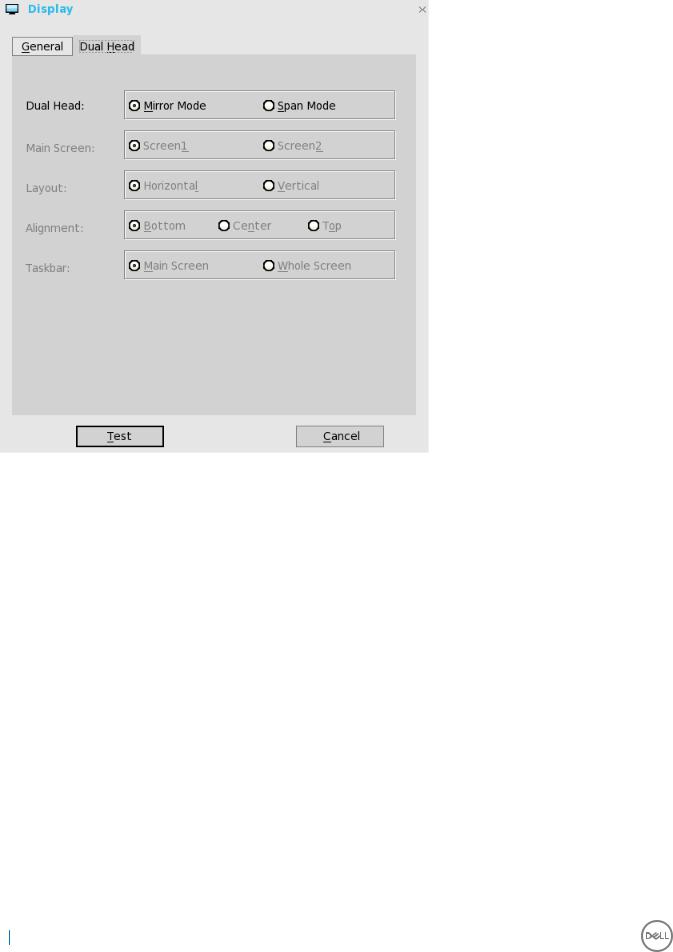
This feature is applicable for supported dual-monitor-capable thin clients only.
aDual Head—Select Mirror Mode to have the two monitors work in a matching state, or Span Mode to have the two monitors work individually.
bMain Screen—Select which of the two monitors you want to be the main screen (Screen1 or Screen2). The other screen is extended from the main screen.
cLayout—Select how you want the two monitors to be oriented to each other.
Horizontal — where you move between the monitors from the left and right of the screens.
Vertical— where you move between the monitors from the top and bottom of the screens.
dAlignment— Select how you want the monitors to be aligned Bottom, Center, or Top.
Bottom means screens are bottom-aligned in a horizontal orientation; Center means screens are center-aligned; Top means screens are top-aligned in a horizontal orientation.
eTaskbar (Classic Desktop Only)—Select under which screen you want the taskbar to appear Whole Screen or Main Screen Gamma Supported Monitors Only— Use the Gamma Setup tab to adjust the saturation values for Red, Green and Blue on VGA connected monitors supporting gamma settings, if you feel the default settings are too light. Be aware that the Gamma Setup tab will be disabled once you click Save+Exit. You can enable it again by setting rgamma={1-100} ggamma={1-100} bgamma={1-100} in the Resolution INI parameter. For more information, see Dell Wyse ThinOS INI Guide.
8 Displays
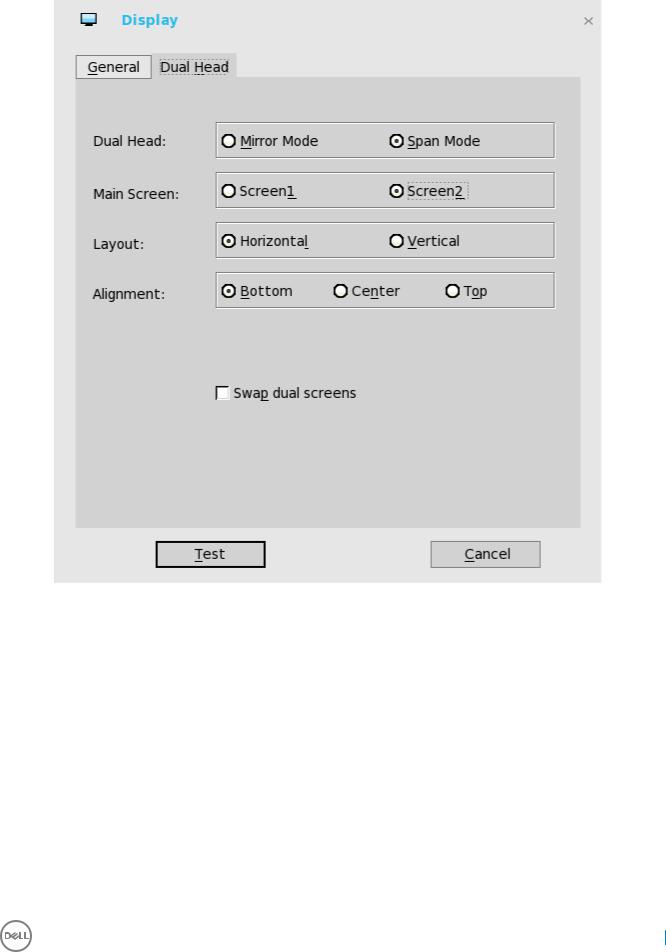
For Swap dual screens, when you set Main Screen to Screen2, an additional check box is displayed at the bottom of the tab that allows you to swap dual screens. If you clear the check box, the Screen1 is usually the left one or the top one in dual display. When you set Main Screen to Screen2, the main screen is changed to the right screen or bottom screen. If you select the Swap dual screens check box, you are able to set Main Screen to Screen2, but still have it at the left side or the top side, which is considered more user friendly.
Configuring your display on Dell Wyse ThinLinux
By default, the Customize your display screen is available in both User mode and Admin mode. Any changes to display preferences made through this screen is saved and available for the built-in thinuser. In a Dual-monitor con•guration, if both monitors are connected, then by default, the monitors are in extended mode. The primary monitor is on the left (monitor 1) and the secondary monitor is on the right (monitor 2). The resolutions of the monitors are auto detected by the system by analyzing the monitor’s capabilities.
1Click the Display tab.
The Customize Your Display page is displayed.
Displays 9

Figure 1. Display Settings
2Select the preferred Resolution from the drop-down list.
3Select the Rotation type from the drop-down list.
•Normal
•Right
•Left
•Upside-down
4Click the ON/OFF button to switch between dual display and mirror mode in a dual monitor con•guration.
5Click the ON/OFF button to enable the Set as primary option. This option allows you to set the selected monitor as primary.
6Click the ON/OFF button to enable the Monitor On/Off option. This option allows you to switch oƒ and switch on the preferred monitor in a dual monitor con•guration.
Configuring dual monitor display on WIE10
You can use the Screen Resolution window to con•gure dual monitor settings on your dual-monitor capable thin client device. To open the Screen Resolution window:
1Log in as an Admin.
2On the Start menu, click Control Panel > Display > Change Display Settings.
The Screen Resolution window is displayed. For detailed instructions on how to con•gure the screen resolution, go to www.microsoft.com.
For information about setting up multiple monitors, refer to Dell documentation.
10 Displays

5
Networks
This section describes about the network con•gurations of Wyse 5060 thin client.
Topics:
•Con•guring network settings on WES7P
•Con•guring the network settings on Dell Wyse ThinOS
•Con•guring the network settings on Dell WyseThinLinux
•Con•guring network settings on WIE10
Configuring network settings on WES7P
If Dell Wyse supported WLAN hardware modules are installed on the thin client, clicking the Network and Sharing Center icon in the Control Panel allows you to:
1Manage Wireless Networks (click the Manage Wireless Networks link):
•Add —Click Add to open and use the wizard to add a wireless network to edit an existing wireless network, right-click it, and then select Properties to open and use the Network Properties dialog box.
•Adapter Properties —Click Adapter Properties to open and use the properties dialog box for the wireless adapter.
•Pro•le Types —Click Profile Types to open and use a dialog box to the enable or disable the ability to create Per User Pro•les.
•Network and Sharing Center - Click Network Sharing Center to return to the Network and Sharing Center dialog box provides network settings, and gives access to network settings.
2Change Adapter Settings click the Change Adapter Settings link:
•Click Organize to open the list of options you can use to organize your network connections.
•Select a connection to display the list of command buttons you can use to view the status, connect to, enable, disable, diagnose, rename, and change the settings of the connection.
3Change Advanced Sharing Settings (click the Change Advanced Sharing Settings link): Select the network pro•le settings you want for each of your networks.
Configuring the network settings on Dell Wyse ThinOS
To con•gure the network settings use the following options:
•Con•guring the general settings.
•Con•guring the DHCP options settings.
•Con•guring the ENET settings.
•Con•guring the WLAN settings.
Networks 11
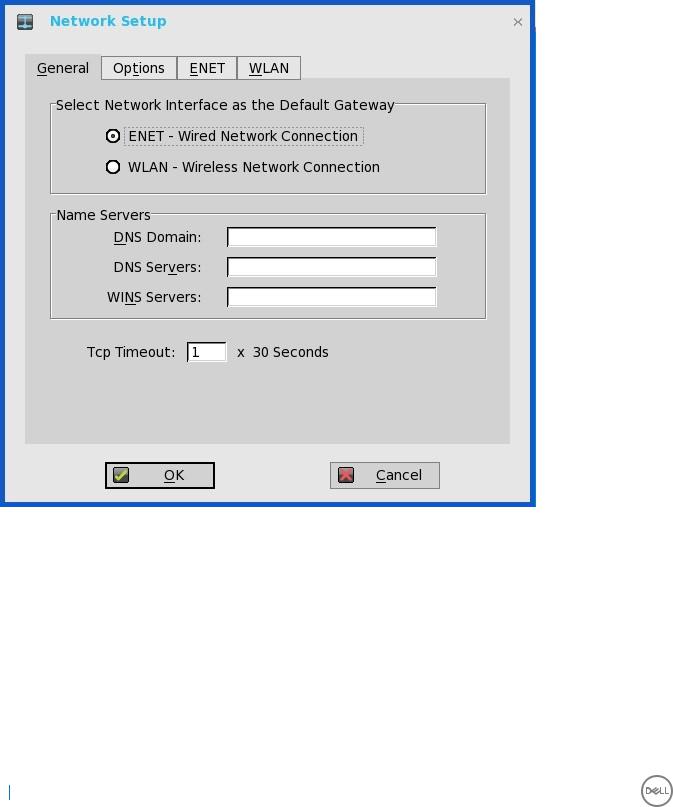
Configuring the General settings
To con•gure the general network settings:
1From the desktop menu, click System Setup, and then click Network Setup. The Network Setup dialog box is displayed.
2 Click the General tab, and use the following guidelines:
aTo set the default gateway, select the type of network interface from the available options.
1Single Network support — Either wireless or wired network is connected.
•ENET — Click this option, if you want set up the Ethernet Wired Network Connection.
•WLAN — Click this option, if you want to set up the Wireless Network Connection.
•If you use wireless network after selecting ENET connection or wired network after selecting WLAN connection, then the system log "WLAN: set default gate way xxx.xxx.xxx.xxx" for •rst case and "ENET: set default gate way xxx.xxx.xxx.xxx" for second case are printed to ensure that the UI setting reflects the actual usage.

 NOTE: The User Interface (UI) will not be changed automatically.
NOTE: The User Interface (UI) will not be changed automatically.
2Dual Network support — Both wireless and wired networks are connected. The default gateway is determined by the UI settings.
b Enter the URL address of the DNS domain in the DNS Domain box.
12 Networks

cEnter the IP address of the DNS server in the DNS Server box.
Use of DNS is optional. DNS allows you to specify remote systems by their host names rather than IP addresses. If a speci•c IP address (instead of a name) is entered for a connection, it is used to make the connection. Enter the DNS domain and the network address of an available DNS server. The function of the DNS domain entry is to provide a default suffix to be used in name resolution. The values for these two boxes may be supplied by a DHCP server. If the DHCP server supplies these values, they replace any locally con•gured values. If the DHCP server does not supply these values, the locally con•gured values will be used.
NOTE: You can enter up to 16 DNS server addresses, separated by a semicolon, comma, or space. The first address is for the primary DNS server and the rest are secondary DNS servers or backup DNS servers .
dEnter the IP address of the WINS server in the WINS Server box.
Use of WINS is optional. Enter the network address of an available WINS name server. WINS allows you to specify remote systems by their host names rather than IP addresses. If a speci•c IP address (instead of a name) is entered for a connection, it is used to make the connection. These entries can be supplied through DHCP, if DHCP is used. DNS and WINS provide essentially the same function, name resolution. If both DNS and WINS are available, the thin client attempts to resolve the name using DNS •rst and then WINS.
You can enter two WINS server addresses (primary and secondary), separated by a semicolon, comma, or space.
eEnter the digit multiplier of 30 seconds in the TCP Timeout box to set the time-out value of a TCP connection. The value must be 1 or 2 which means the connection time-out value is from 1x30= 30 seconds to 2x30= 60 seconds. If the data for connecting to the server is not acknowledged and the connection is timed out, setting the time-out period retransmits the sent data and again tries to connect to the server till the connection is established.
3 Click OK to save the settings.
Configuring the DHCP Options Settings
To con•gure the options settings:
1From the desktop menu, click System Setup, and then click Network Setup. The Network Setup dialog box is displayed.
2Click the Options tab, and use the following guidelines:
Networks 13
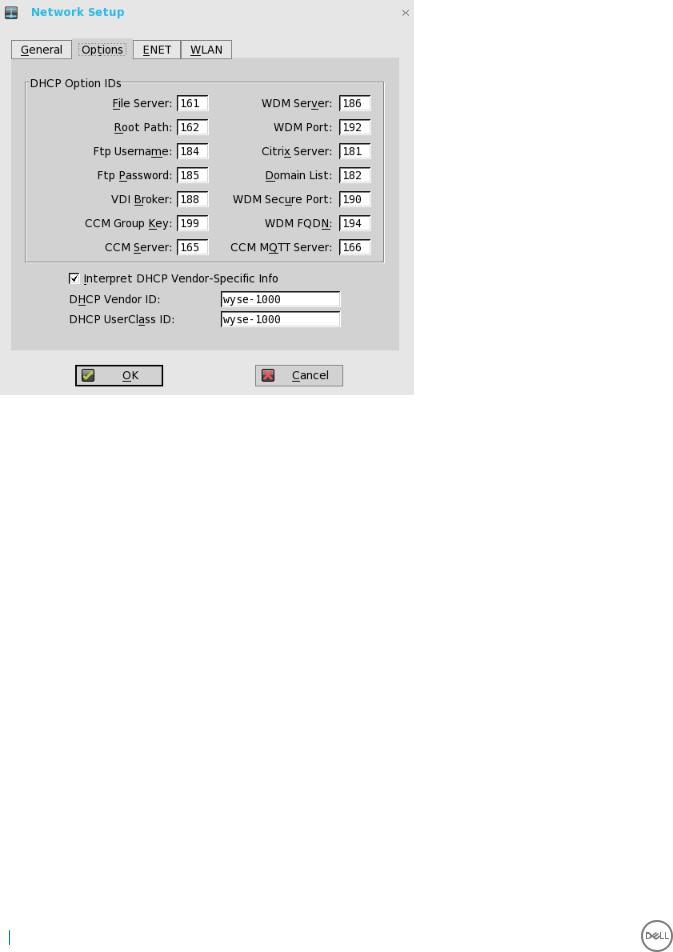
aDHCP Option IDs — Enter the supported DHCP options. Each value can only be used once and must be between 128 and 254.
bInterpret DHCP Vendor-Specific Info — Select this check box for automatic interpretation of the vendor information.
cDHCP Vendor ID — Shows the DHCP Vendor ID when the dynamically allocated over DHCP/BOOTP option is selected.
dDHCP UserClass ID — Shows the DHCP UserClass ID when the dynamically allocated over DHCP/BOOTP option is selected.
3 Click OK to save the settings.
Configuring the ENET Settings
To con•gure the ENET settings:
1From the desktop menu, click System Setup, and then click Network Setup. The Network Setup dialog box is displayed.
2Click the ENET tab, and use the following guidelines:
14 Networks
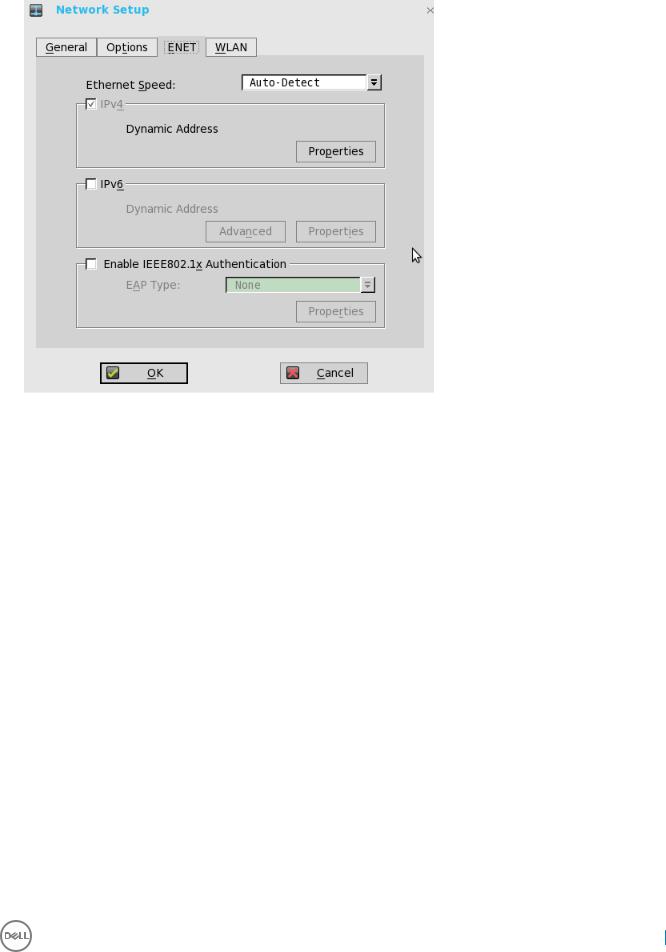
aEthernet Speed — Normally the default (Auto-Detect) should be selected, but another selection can be made if automatic negotiation is not supported by your network equipment. Selections include Auto-Detect, 10 MB Half-Duplex, 10 MB FullDuplex, 100 MB Half-Duplex, 100 MB Full-Duplex, and 1 GB Full-Duplex.
The 10 MB Full-Duplex option can be selected locally at the device, however, this mode may need to be negotiated through
AutoDetect.
bThe IPV4 check box is selected by default. Click Properties to set various options supported by IPV4.
•Dynamically allocated over DHCP/BOOTP — Selecting this option enables your thin client to automatically receive information from the DHCP server. The network administrator must con•gure the DHCP server using DHCP options to provide information. Any value provided by the DHCP server replaces any value entered locally on the Options tab, however, locally entered values are used if the DHCP server fails to provide replacement values.
•Statically specified IP Address — Select this option to manual enter the IP Address, Subnet Mask and Default Gateway:
•IP Address — Must be a valid network address in the server environment. The network administrator must provide this information.
•Subnet Mask — Enter the value of the subnet mask. A subnet mask is used to gain access to machines on other subnets. The subnet mask is used to diƒerentiate the location of other IP addresses with two choices: same subnet or other subnet. If the location is other subnet, messages sent to that address must be sent through the Default Gateway, whether speci•ed through local con•guration or through DHCP. The network administrator must provide this value.
•Default Gateway — Use of gateways is optional. Gateways are used to interconnect multiple networks (routing or delivering IP packets between them). The default gateway is used for accessing the internet or an intranet with multiple subnets. If no gateway is speci•ed, the thin client can only address other systems on the same subnet. Enter the address of the router that connects the thin client to the internet. The address must exist on the same subnet as the thin client as de•ned by the IP address and the subnet mask. If DHCP is used, the address can be supplied through DHCP.
cSelect the IPV6 check box, and then click Advanced to select various IPV6 supported setting options from the available check boxes.
dClick properties and use the following guidelines:
•Wait DHCP — Selecting this option enables your thin client to wait for IPV6 DHCP before the sign-in, if not selected the system will only wait for IPV4 DHCP if enabled.
•Dynamically allocated over DHCP/BOOTP — Selecting this option enables your thin client to automatically receive information from the DHCP server. The network administrator must con•gure the DHCP server (using DHCP options) to
Networks 15

provide information. Any value provided by the DHCP server replaces any value entered locally on the Optionstab, however, locally entered values are used if the DHCP server fails to provide replacement values.
•Statically specified IP Address — Select this option to manually enter the IP Address, Subnet Mask and Default Gateway.
•IP Address — Must be a valid network address in the server environment. The network administrator must provide this information.
•Subnet Mask — Enter the value of the subnet mask. For more information, see various options supported by IPV4 in this section.
•Default Gateway — Use of gateways is optional. For more information, see various options supported by IPV4 in this section.
•DNS Servers — Use of DNS is optional. DNS allows you to specify remote systems by their host names rather than IP addresses. If a speci•c IP address (instead of a name) is entered for a connection, it is rather than DNS is used to make the connection. Enter the network address of an available DNS server. The value for this box may be supplied by a DHCP server. If the DHCP server supplies this value, it replaces any locally con•gured value. If the DHCP server does not supply this value, the locally con•gured value is used.
eSelect the check box to enable IEEE802.1x Authentication.
•EAP Type — If you have enabled the Enable IEEEE 802.1x authentication check box, select the EAP Type option you want (TLS, LEAP or PEAP).
•TLS — If you select the TLS option, click Properties to open and con•gure the Authentication Properties dialog box.
• Select the Validate Server Certificate check box because it is mandatory to validate your server certi•cate.
NOTE:
The CA certi•cate must be installed on the thin client. Also note that the server certi•cate text •eld supports a maximum of approximately 127 characters, and supports multiple server names.
•If you select the Connect to these servers check box, the box is enabled where you can enter the IP address of server.
•Click Browse to •nd and select the Client Certi•cate •le and Private Key •le you want.
The following kinds of server names are supported — all examples are based on Cert common name company.dell.com
NOTE:
Using only the FQDN, that is company.wyse.com does not work. You must use one of the options (note that *.dell.com is the most common option as multiple authentication servers may exist): servername.dell.com
*.dell.com
*dell.com
*.com
fLEAP — If you select the LEAP option, click Properties to open and con•gure the Authentication Properties dialog box. Be sure to use the correct username and password for authentication. The maximum length for the username or the password is 64 characters.
gPEAP — If you select the PEAP option, click Properties to open and con•gure the Authentication Properties dialog box. Be sure to select either EAP_GTC or EAP_MSCHAPv2, and then use the correct username, password and domain. Validate Server Certi•cate is optional.
NOTE:
The server certi•cate text box for LEAP and PEAP supports a maximum of approximately 127 characters, and supports multiple server names.
hTo con•gure EAP-GTC, enter the username only. The password or PIN is required when authenticating. To con•gure EAP-MSCHAPv2, enter the username, password and domain.
IMPORTANT: The domain/username in the username box is supported, but you must leave the domain box blank.
16 Networks

The CA certi•cate must be installed on the thin client and the server certi•cate is forced to be validated. When EAPMSCCHAPV2 is selected in EAP type in the Authentication Properties dialog box (for PEEP IEEE802.1x authentication), an option to hide the domain is available for selection. Username and Password boxes are available for use, but the Domain text box is disabled.
3 Click OK to save the settings.
Configuring the WLAN Settings
1From the desktop menu, click System Setup, and then click Network Setup. The Network Setup dialog box is displayed.
2Click the WLAN tab, and use the following guidelines:
aAdd— Use this option to add and con•gure a new SSID connection.
You can con•gure the SSID connection from the available security type options.
Networks 17
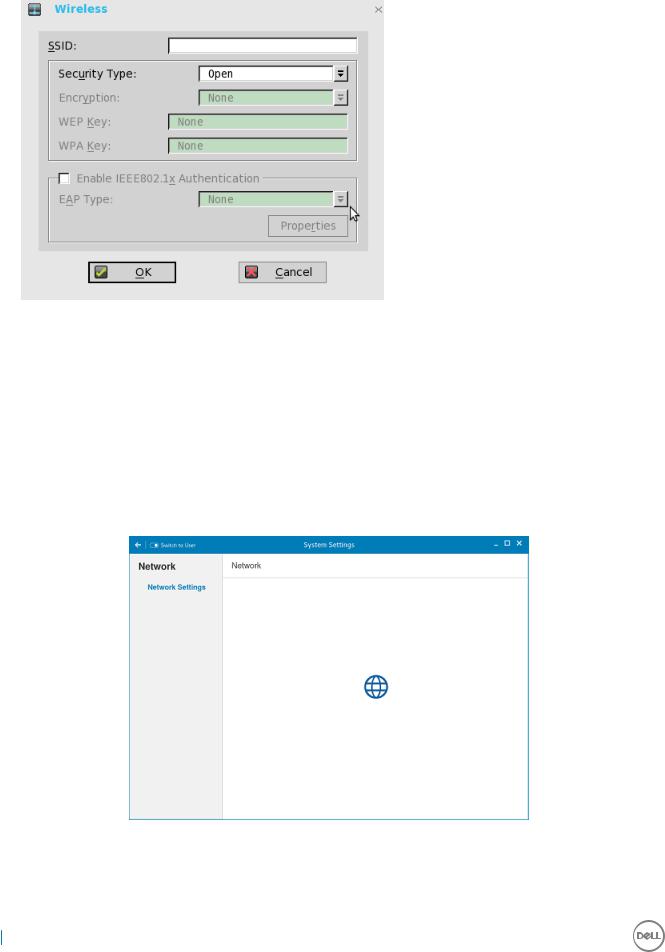
bAfter you con•gure the SSID connection, the added SSID connection is listed on the page of the WLAN tab.
cRemove — Use this option, if you want to remove a SSID connection by selecting the SSID connection from the list.
dProperties — Use this option to view and con•gure the authentication properties of a SSID connection that is displayed in the list.
eSelect the Disable Wireless Device check box, if you want to disable a wireless device.
3 Click OK to save the settings.
Configuring the network settings on Dell WyseThinLinux
On the System Settings page, click the Network tab to view the Network Settings page. 1 Click the Network icon.
Figure 2. Network Settings
2 The Network settings page is displayed. In the left-pane, the following tabs are available for you to con•gure.
18 Networks
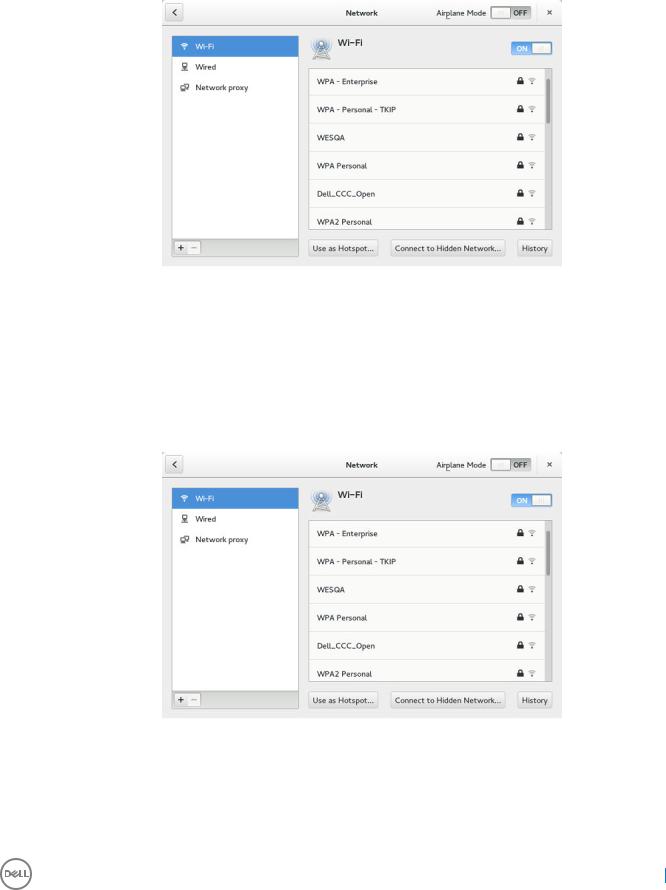
•Wi-Fi
•Wired
•Network proxy
Figure 3. Network Settings page
Configuring the wi-fi settings
To con•gure the Wi-Fi settings, perform the following steps:
1In the left-pane, click Wi-Fi tab.
2Click the ON/OFF button to enable or disable the Wi-Fi option. The list of wireless SSID is displayed if broadcast is enabled.
Figure 4. Wi-Fi Settings
3To connect to Wi-Fi connection, select the preferred wireless SSID from the list displayed.
4Click the ON/OFF button to enable or disable the Airplane Mode option after you log in to the session.
5Click the Connect to Hidden Wi-Fi Network button. The Connect to Hidden Wi-Fi Network window is displayed.
Networks 19

Figure 5. Hidden Wi-Fi Network
6Enter the name and security details of the hidden network that you want to connect to.
Table 1. Hidden network
Parameter |
Description |
|
|
Connection |
From the drop-down list, select the type of connection. |
|
|
Network name |
Enter the preferred network name. |
|
|
Wi-Fi security |
From the drop-down list, select the security type. |
|
|
7 On the Network page, click the History button to view the previous Wi-Fi connections and details.
Configuring wired network connection settings
To con•gure the wired connection settings, perform the following steps:
1Click the Wired tab. The following attributes are displayed if the network cable is connected to your thin client and wired connection is established.
•IP Address
•Hardware Address
•Default Route
•DNS

 NOTE: After the network is disconnected, only hardware address and last used information are displayed.
NOTE: After the network is disconnected, only hardware address and last used information are displayed.
2On the lower-right corner of the page, click the Settings icon to con•gure the Wired Network connections. a In the Details tab, the following attributes are displayed.
•IP Address
•Link Speed
•Hardware Address
•Default Route
•DNS
3Click the Security tab to con•gure the 802.1x security settings.
aClick the ON button to enable the 802.1x Security for your network connection.
bFrom the Authentication drop-down list, select the type of authentication you want to set for your network connection. The available options are:
•MDS
•TLS
•FAST
20 Networks

•Tunneled TLS
•Protected EAP (PEAP)
cIf the authentication type is selected as MD5, you must con•gure the following options:
Table 2. MD5 configuration
Parameter |
Description |
|
|
Username |
Enter the Username for the network connection. |
|
|
Password |
Enter the password you want to set for the connection. |
|
|
Ask for this password every time |
If this check box is selected, you will be prompted to enter the |
|
password every time when you connect to the network. |
|
|
Show Password |
Select this check box if you want to allow the user to view the |
|
hidden password. |
|
|
dIf the authentication type is selected as TLS, you must con•gure the following options.
Table 3. TLS
Parameter |
Description |
|
|
Identity |
Enter your Identity. |
|
|
User certi•cate |
Select the User certi•cate from the list or upload your |
|
personal certi•cate stored locally. |
|
To upload your personal certi•cate, click the Folder icon, and |
|
then browse to the location where you have stored the |
|
certi•cate. |
|
|
CA Certi•cate |
Select the CA certi•cate from the list or upload your CA |
|
certi•cate stored locally. |
|
To upload your CA certi•cate, click the Folder icon, and then |
|
browse to the location where you have stored the certi•cate. |
|
|
Private key |
Select the private key from the list or upload your private key |
|
stored locally. |
|
To upload your private key, click the Folder icon, and then |
|
browse to the location where you have stored the certi•cate. |
|
|
Private key password |
Enter the password that you want to set for the private key. |
|
|
Show Password |
Select this check box if you want to allow the user to view the |
|
hidden password. |
|
|
e If the authentication type is selected as FAST, you must con•gure the following options.
Table 4. FAST
Parameter |
Description |
|
||
|
|
|
|
|
Anonymous identity |
Enter the username you want to set for Anonymous |
|
||
|
Authentication Identity. |
|
||
|
|
|
|
|
PAC provisioning |
Select this check box to enable the PAC provisioning |
|
||
|
authentication. From the drop-down list, select any of the |
|
||
|
following PAC provisioning options: |
|
||
|
|
|
|
|
|
Networks |
|
|
21 |
|
|
|||
|
|
|
|
|
